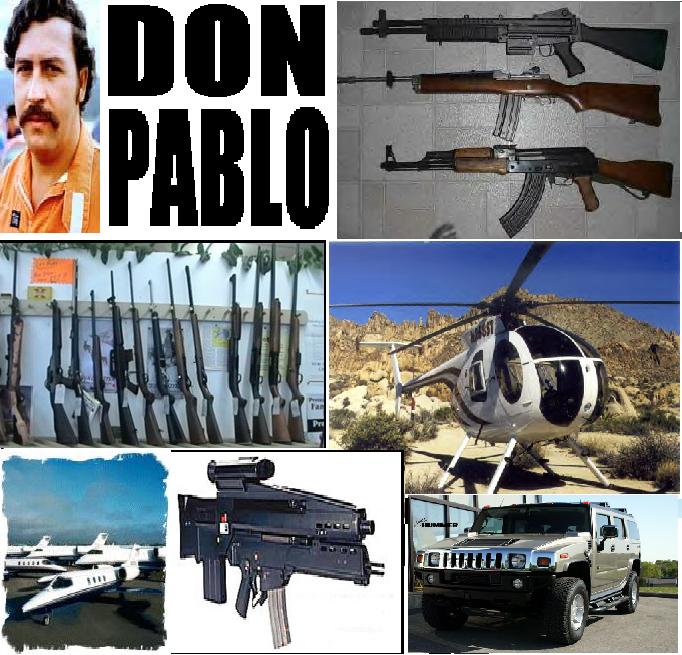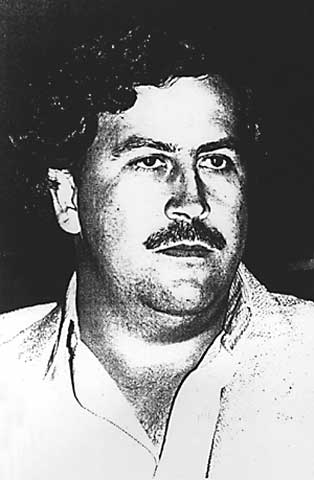see alsoSynopsis of Killing Pablo (2001) by Mark Bowden Pablo Escobar
THE LIFE AND DEATH OF PABLO ESCOBAR
Escobar's escape opens a door for the Americans
Morris D. Busby, the U.S. ambassador to Colombia, was awakened by two phone calls early Wednesday, July 22, 1992, at a house in Chevy Chase, Md., where he and his wife were staying with friends.A deadly manhunt guided by the U.S.
EIGHT YEARS AGO, at the request of the Colombian government, U.S. military and spy forces helped fund and guide a massive manhunt that ended with the killing of Pablo Escobar, the richest cocaine trafficker in the world.Escobar's rise to power: From small-time gangster to the terror of Colombia
Pablo Escobar was arguably the richest and most violent criminal in history. Forbes Magazine in 1989 listed him as the seventh-richest man in the world.A top-secret electronic tracking unit rejoins the hunt
By walking out of prison in July of 1992, Pablo Escobar had done his enemies a favor. He had gone from prisoner to prey.With Escobar eluding capture, Americans summon Delta Force
In the three years since their unit had arrived in Colombia, the men of Centra Spike had come to recognize not just the voice of Pablo Escobar, but his idiosyncrasies and unique personal style.Delta Force, in Bogota, gets the lay of a confusing land
Hopes at the U.S. Embassy soared when a Delta Force team led by Col. Jerry Boykin arrived in Bogota late in the evening of Sunday, July 26, 1992.Raring to get started, Delta learns its limits
The Delta soldiers who arrived in Colombia just four days after Pablo Escobar left his prison in July 1992 had initially hoped to hunt down the notorious narco-terrorist themselves. Given the clumsy track record of the Colombians, it seemed the best chance of finding Escobar quickly.Delta, Colombians get off to bad start
After an unnerving trip from Bogota, the two Delta soldiers finally arrived at the Medellin headquarters of the Colombian police units searching for Pablo Escobar in July of 1992.Incorruptible colonel rejoins Escobar pursuit
Col. Hugo Martinez was delighted when he got the news, in Madrid, that Pablo Escobar had walked out of jail. No one knew better than the colonel what a charade that imprisonment had been. Martinez had spent nearly three years hunting Escobar before his infamous 1991 "surrender" to a luxury prison cell guarded by his cronies, which Martinez viewed as the evasive drug lord's most ingenious escape to date.Escobar's nemesis hones his troops for the hunt
Sometimes the fate of an entire nation can hinge on the integrity of one man. Police Col. Hugo Martinez had been handed a suicide mission in 1989 - hunting down drug kingpin Pablo Escobar. This was during the Colombian government's first war against Escobar, before Martinez was called back in 1992 to rejoin the hunt.Luxury 'prison' affords a rare look at Escobar
Four days after Pablo Escobar's escape from prison in July of 1992, a team of American DEA agents took a leisurely tour of La Catedral, the site of Escobar's luxury prison suite.A conditional offer to surrender
Two days after his escape from prison in July of 1992, Pablo Escobar sent a taped statement to selected Colombian TV and radio reporters. It was signed: "Colombian jungle zone, Thursday, July 24, 1992. Pablo Escobar and comrades."Frustrating hunt gives rise to vigilantism
On Jan. 30, 1993, a car bomb exploded in Bogota, blowing a crater several feet deep in the street and sidewalk and taking a savage bite out of a bookstore.Homegrown Escobar enemy joins fight
Officially, the U.S. Embassy in Bogota was silent on the sudden emergence in early 1993 of Los Pepes (People Persecuted by Pablo Escobar), a vigilante group apparently dedicated to violent retribution against the fugitive drug lord.Escobar's powerful foes ally against him
The hunt for Pablo Escobar grew uglier in 1993. In his desk at the Search Bloc headquarters, Col. Hugo Martinez kept a growing pile of grisly photographs of the dead. Displaying the photos to a Delta Force operator one afternoon, the colonel said of Medellin cartel members his men had not yet found, "As long as I'm the commander here, they're not going to live."Angry widow aids pursuit of Escobar
At least one person in Colombia felt there was no mystery at all about the vigilante group that called itself Los Pepes. The day after several of Pablo Escobar's properties were bombed in January 1993, the fugitive drug boss sent a note to Col. Hugo Martinez, who headed the police Search Bloc.A former ally offers a profile of Escobar
After her husband was murdered by his former boss Pablo Escobar, Dolly Moncada began providing valuable information to the Americans who were helping direct and finance the hunt for the fugitive drug lord. Among her suggestions was that the authorities talk to Colombian drug traffickers held in American jails.A rivalry grows between spy units
The Americans based at the Search Bloc headquarters in Medellin occupied a small room where they slept on cots or air mattresses. They covered the walls with giant photo-maps of the city of Medellin and surrounding areas.A traitor within the Search Bloc
Up in their Beechcraft spy plane over Medellin one day, the Centra Spike operators were stunned by what they overheard. They had just picked up a brief radio transmission from Pablo Escobar. They plotted the coordinates, then sent the data to the Search Bloc headquarters. There, the unit's commander, Col. Hugo Martinez, shared the information with his top officers.Los Pepes' killings put heat on Escobar
By January 1993, the Americans directing the search for Pablo Escobar had managed to produce elaborate organizational charts for his Medellin drug cartel. The charts were displayed in the secret vault at the U.S. Embassy in Bogota and inside the Delta Force outpost in MedellinEscobar complains of unfair treatment
If Pablo Escobar had ever doubted that the United States was hot on his trail, those doubts vanished after the U.S. Embassy in Bogota refused to issue visas for his wife and children to flee to the United States in February 1993.U.S. spy data, vigilante killings start to coincide
In the fifth-floor vault at the U.S. Embassy in Bogota, Centra Spike analysts were not missing the distinct pattern in the Los Pepes hits. The death squad was killing off the white-collar infrastructure of Escobar's organization, targeting his money-laundering experts, bankers, lawyers and extended family - names listed on the very charts that Centra Spike's surveillance experts and the CIA had painstakingly assembled over the previous six months.'Tacit support' for tough tactics
Despite U.S. doubts about Los Pepes, the group's violent work continued Concerned that the manhunt he was leading might somehow be linked to the vigilantes of Los Pepes, U.S. Ambassador Morris Busby wrote a long, secret memo to the State Department in August 1993.Martinez pushes ahead with the hunt
Col. Hugo Martinez did not protest when he learned that his superiors in Bogota were planning to replace him, and had even picked his successor. He offered to step aside. As the first anniversary of Pablo Escobar's escape passed in July 1993, there seemed to be better reasons to leave than to stay.Search Bloc leader tries to keep his son from joining the manhunt
Col. Hugo Martinez did not want his son coming to Medellin. Without telling the young man, the colonel had twice intervened to block his transfer to that dangerous city. Now he would block him again.Pressure mounts on Escobar family
Lt. Hugo Martinez and his team of electronic surveillance experts started getting better with their funny little boxes. They combined the various components, American, French and German, and developed techniques through trial and error.A father and son's high-tech connection
On one of his many visits to the apartment building that housed Pablo Escobar's wife and family in Medellin, the Colombian prosecutor Fernando Correa had noticed several cellular phones. On another visit, he discovered a radio transceiver hidden behind the trap door on the ceiling of the building elevator.Mission stirs concern back home
As the hunt wore on late into the summer of 1993, at least one member of the top brass at the Pentagon began to worry about how far the Americans in Colombia seemed willing to go to get Pablo Escobar.Trackers get a line on elusive Escobar
The special Colombian police squad sent to Medellin with its curious little portable direction-finding kits was having no luck finding Pablo Escobar. The Search Bloc was continuing to provide security for the men, but the unit itself was considered a joke. Things got so bad that Col. Hugo Martinez, the Search Bloc commander, finally sent the unit's leaders back to Bogota.As the hunters close in, a narrow escape
By the autumn of 1993, Pablo Escobar was in bad shape. His lifelong, fabulously wealthy organization had been dismantled and terrorized by the vigilantes of Los Pepes.Escobar's wife, children become the bait
On the night of Nov. 26, 1993, the U.S. Embassy in Bogota learned that Pablo Escobar's wife and children were planning once more to flee Colombia.Escobar employs a ruse as his family takes flight
By November of 1993, Gustavo de Greiff was becoming a problem. He was the Fiscal General, Colombia's top federal prosecutor, and he was now working in open defiance of President Cesar Gaviria on the matter of Pablo Escobar. De Greiff had told Gaviria that he disagreed with effectively holding the Escobar family hostage. As an elected official - an "independent entity," he called himself - he had decided to help the family leave Colombia in order to complete his deal for the fugitive's surrender.Denied escape, Escobar's family returns home
When the Lufthansa plane carrying the family of Pablo Escobar finally landed in Frankfurt, Germany, on a Sunday afternoon in November 1993, it was forced to taxi to a remote spot on an alternate runway, out of the view of press waiting in the terminal.Ever elusive Escobar still intent on settling scores
After Hugo Martinez's success in tracking down a Medellin drug dealer with his police unit's high-tech gear, his father gave him a few days off to visit his wife and children in Bogota. But on Hugo's first night back, in late November 1993, Pablo Escobar started issuing phone threats, which were traced to a neighborhood in Medellin.Killing Pablo
Pablo Escobar was the world's richest and most brutal drug trafficker. This is the story of what happened when the Colombian government asked the United States to help hunt him down.
2007
Cocaine, Inc
Mexican cocaine
Cocaine resources
Colombian cocaine
Pablo Escobar Redux?
Benjamin Arellano Felix
Videos Of Pablo Escobar
Colombian-UK connection
The Memory of Pablo Escobar
Shooting down planes to resume
The man who killed Pablo Escobar
$2M worth of cocaine found in banana boxes
Refs
Home
HedWeb
Cocaine, Inc
Future Opioids
BLTC Research
Wirehead Hedonism
Utopian Pharmacology
Mexican Cocaine Cartels
The Hedonistic Imperative
When Is It Best To Take Crack Cocaine?
The Responsible Parent's Guide To
Healthy Mood Boosters For All The Family

